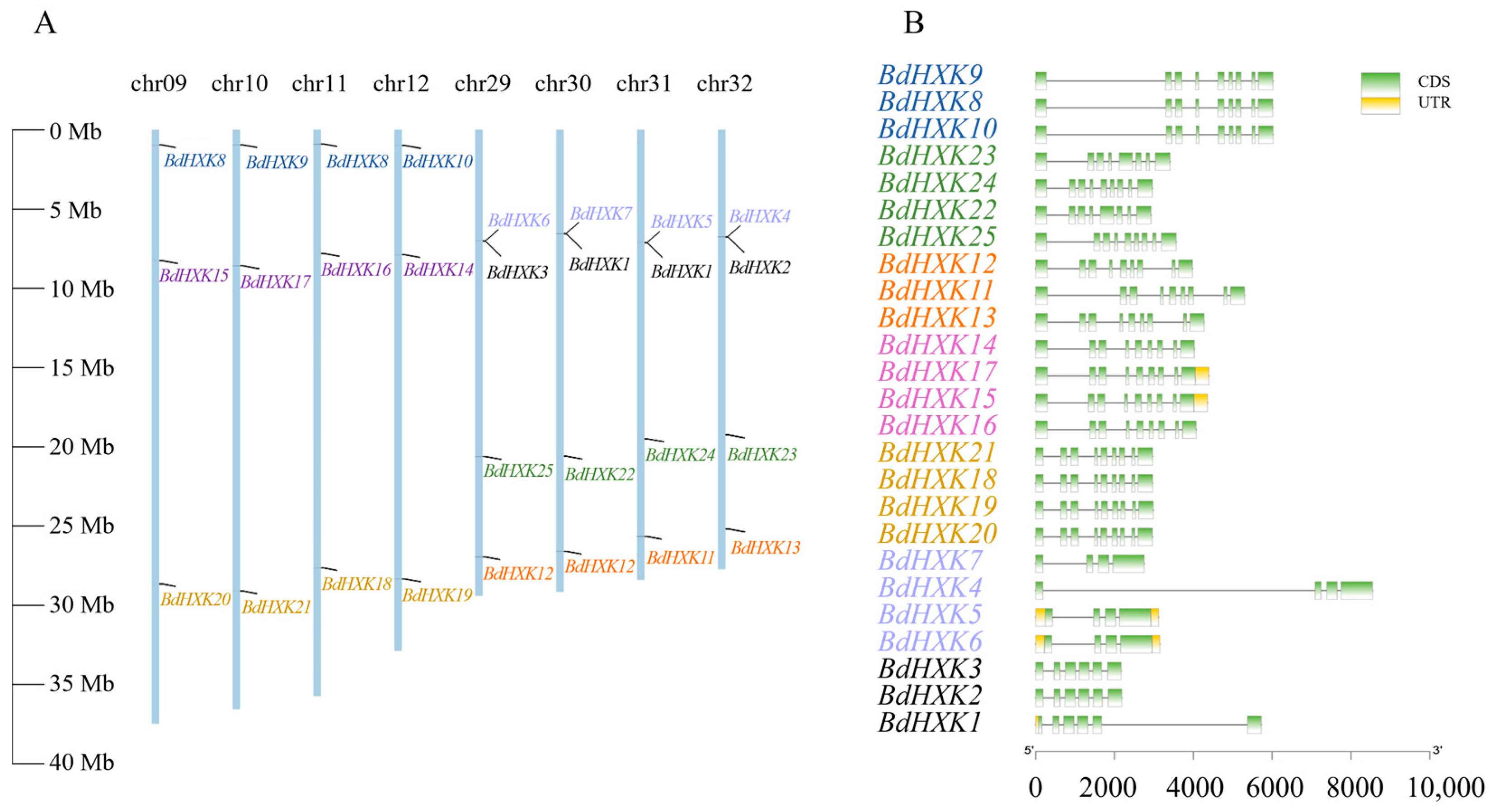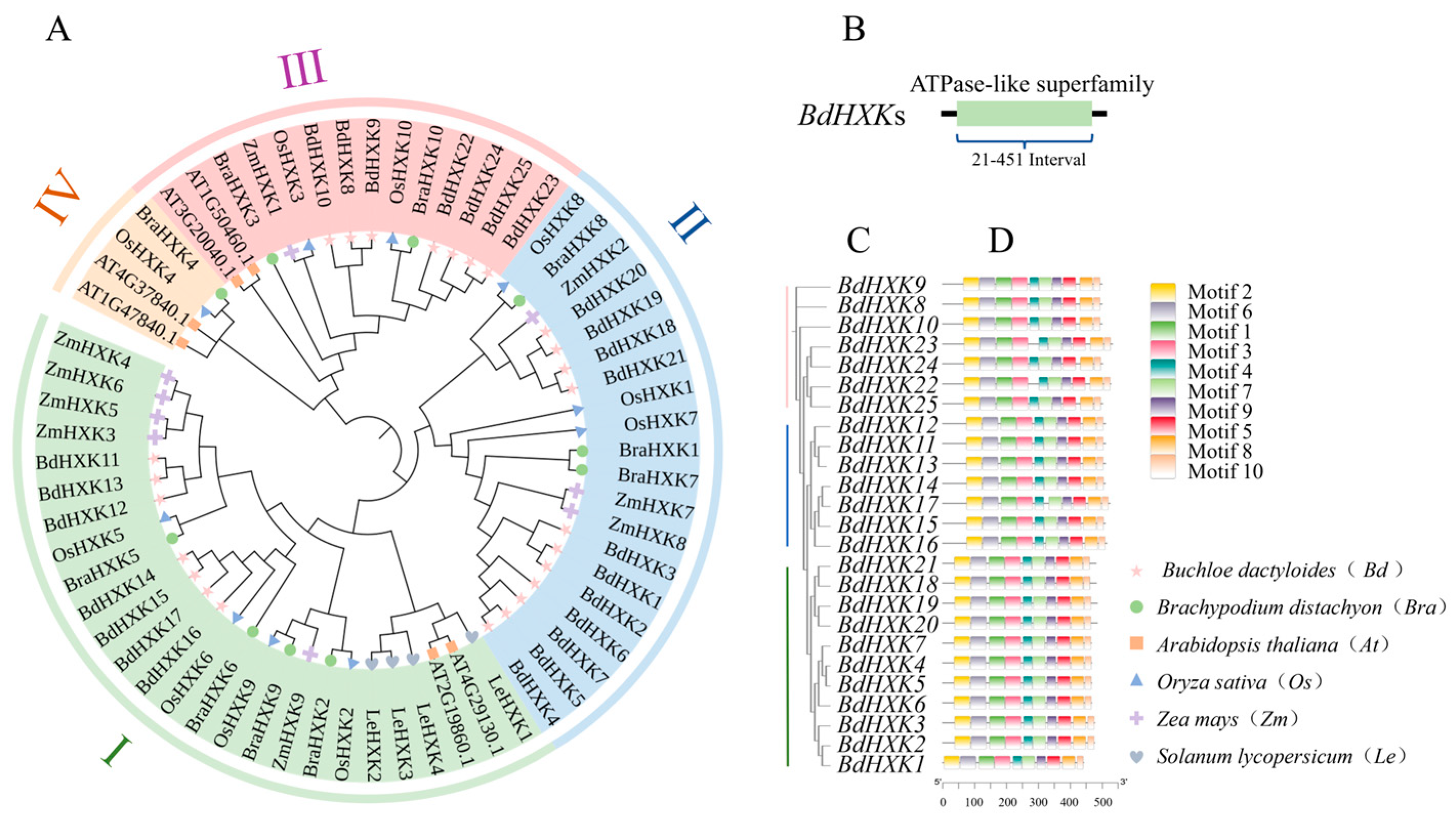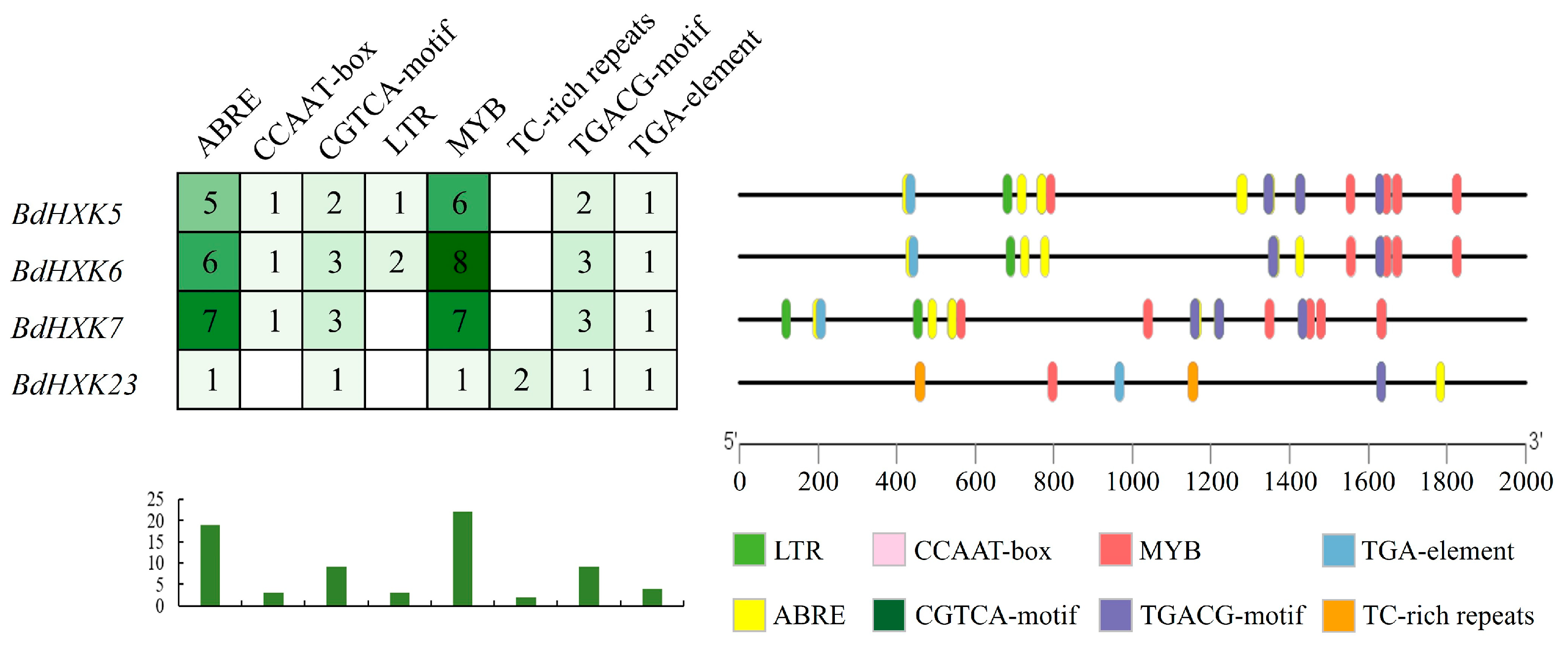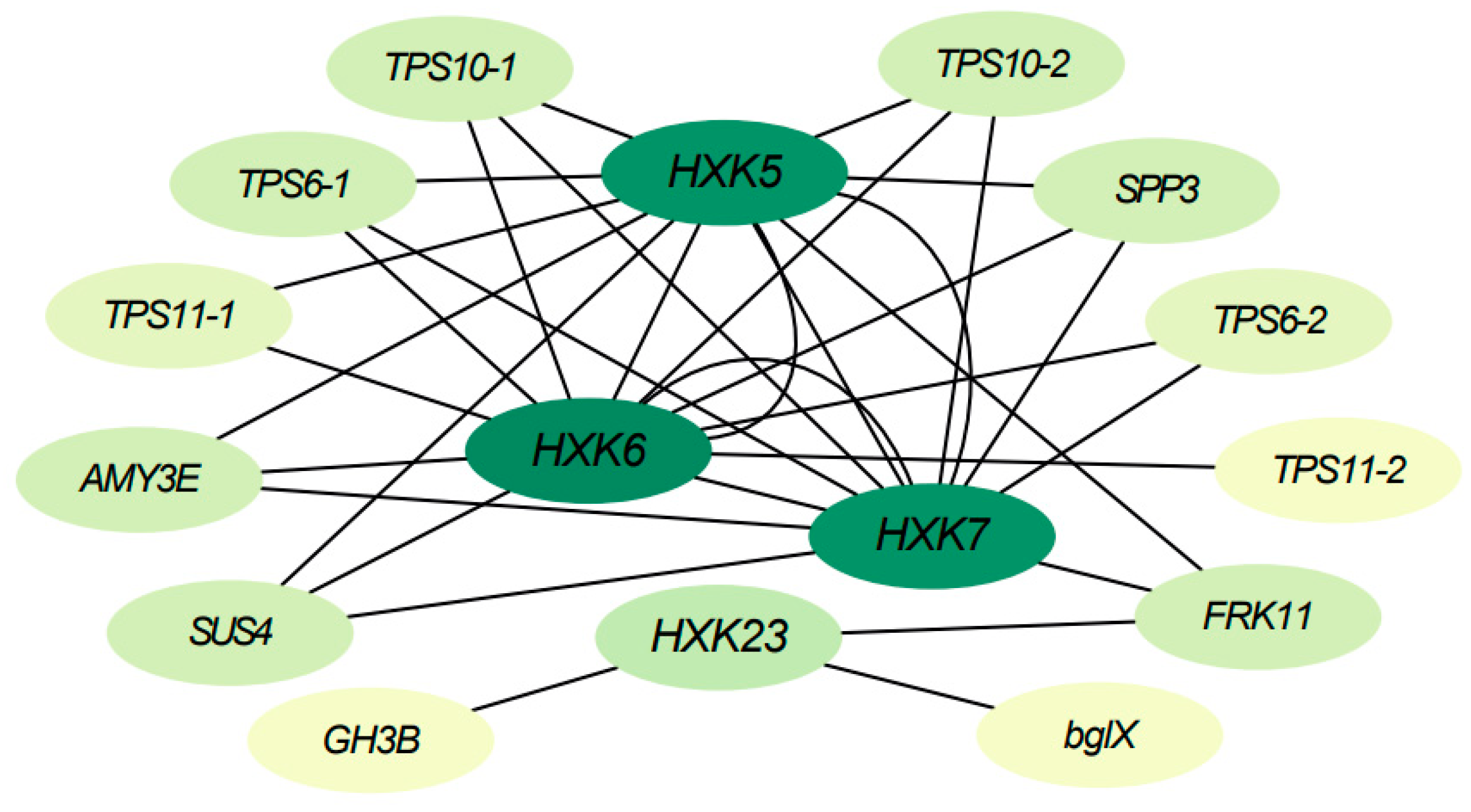Identification of HXK Gene Family and Expression Analysis of Salt Tolerance in Buchloe dactyloides
Abstract
1. Introduction
2. Results
2.1. Identification and Physicochemical Property Analysis of B. dactyloides HXK Family Members
2.2. Chromosomal Localization and Gene Structure Analysis of the B. dactyloides HXK Gene Family
2.3. Phylogenetic Tree and Conserved Motif Analysis of the B. dactyloides HXK Gene Family
2.4. qRT-PCR Validation Analysis of the B. dactyloides HXK Family Under Salt Stress
2.5. Tissue-Specific Expression Analysis of Key B. dactyloides HXK Genes
2.6. Promoter Analysis of Key Members of the B. dactyloides HXK Gene Family
2.7. Correlation Network Analysis
3. Discussion
4. Materials and Methods
4.1. Experimental Materials and Salt Stress Treatment
4.2. Identification and Physicochemical Property Analysis of B. dactyloides HXK Gene Family Members
4.3. Phylogenetic Tree Construction and Salt Tolerance Expression Analysis of the B. dactyloides HXK Gene Family
4.4. Chromosomal Localization, Structure Analysis, Conserved Domain Analysis, Conserved Motif Analysis, and Cis-Acting Element Analysis of the B. dactyloides HXK Gene Family
4.5. Real-Time Quantitative PCR (RT-qPCR) Detection
4.6. WGCNA Analysis of the B. dactyloides HXK Gene Family
4.7. Data Analysis
5. Conclusions
Supplementary Materials
Author Contributions
Funding
Data Availability Statement
Conflicts of Interest
References
- Guo, L.; Meng, H.; Teng, K.; Fan, X.; Zhang, H.; Teng, W.; Yue, Y.; Wu, J. Effects of Nitrogen Forms on the Growth and Nitrogen Accumulation in Buchloe dactyloides Seedlings. Plants 2022, 11, 2086. [Google Scholar] [CrossRef] [PubMed]
- Webb, J.R.; John, J. The life history of buffalo grass. Trans. Kans. Acad. Sci. 1941, 44, 58–75. [Google Scholar] [CrossRef]
- Food and Agriculture Organization of the United Nations. World Soil Day: The Food and Agriculture Organization of the United Nations Emphasizes That Soil Salinization Poses a Threat to Global Food Security. Available online: https://www.fao.org/newsroom/detail/world-soil-day-fao-highlights-threat-of-soil-salinization-to-food-security-031221/ (accessed on 1 January 2025).
- Daliakopoulos, I.N.; Tsanis, I.K.; Koutroulis, A.; Kourgialas, N.N.; Varouchakis, A.E.; Karatzas, G.P.; Ritsema, C.J. The threat of soil salinity: A Europeans calere view. Sci. Total Environ. 2016, 573, 727–739. [Google Scholar] [CrossRef] [PubMed]
- Birhanie, Z.M.; Yang, D.; Luan, M.; Xiao, A.; Liu, L.; Zhang, C.; Biswas, A.; Dey, S.; Deng, Y.; Li, D. Salt Stress Induces Changes in Physiological Characteristics, Bioactive Constituents, and Antioxidants in Kenaf (Hibiscus cannabinus L.). Antioxidants 2022, 11, 2005. [Google Scholar] [CrossRef] [PubMed]
- Kim, H.B.; Cho, J.I.; Ryoo, N.; Shin, D.H.; Park, Y.I.; Hwang, Y.S.; Lee, S.K.; An, G.; Jeon, J.S. Role of rice cytosolic hexokinase OsHXK7 in sugar signaling and metabolism. J. Integr. Plant Biol. 2016, 58, 127–135. [Google Scholar] [CrossRef]
- Karve, A.; Rauh, B.L.; Xia, X.; Kandasamy, M.; Meagher, R.B.; Sheen, J.; Moore, B.D. Expression and evolutionary features of the hexokinase gene family in Arabidopsis. Planta 2008, 228, 411–425. [Google Scholar] [CrossRef] [PubMed]
- Cho, J.I.; Ryoo, N.; Eom, J.S.; Lee, D.W.; Kim, H.B.; Jeong, S.W.; Lee, Y.H.; Kwon, Y.K.; Cho, M.H.; Bhoo, S.H.; et al. Role of the rice hexokinases OsHXK5 and OsHXK6 as glucose sensors. Plant Physiol. 2008, 149, 745–759. [Google Scholar] [CrossRef]
- Zhang, Z.B.; Zhang, J.W.; Chen, Y.J.; Li, R.F.; Wang, H.Z.; Ding, L.P.; Wei, J.H. Isolation, structural analysis, and expression characteristics of the maize (Zea mays L.) hexokinase gene family. Mol. Biol. Rep. 2014, 41, 6157–6166. [Google Scholar] [CrossRef] [PubMed]
- Granot, D. Role of tomato hexose kinases. Funct. Plant Biol. 2007, 34, 564–570. [Google Scholar] [CrossRef] [PubMed]
- Li, S.; Liu, Y.; Qin, X.; He, X.; Han, S.; Lv, Y.; Deng, Z.; Zeng, G.; Gao, X.; Hu, Y.; et al. Isolation, structure analysis and expression characterization of the Hexokinase gene family in Sorghum bicolor. 3 Biotech 2025, 15, 20. [Google Scholar] [CrossRef]
- Wang, P.; Huo, J.; Liu, T.; Liang, G.; Mao, J. Identification and Expression Analysis of the HXK Gene Family in Grapes. Acta Agric. Boreali-Sin. 2020, 35, 57–64. [Google Scholar]
- Zhang, C.; Zhang, L.; Fu, J.; Dong, L. Isolation and characterization of hexokinase genes PsHXK1 and PsHXK2 from tree peony (Paeonia suffruticosa Andrews). Mol. Biol. Rep. 2020, 47, 327–336. [Google Scholar] [CrossRef]
- Lugassi, N.; Kelly, G.; Arad, T.; Farkash, C.; Yaniv, Y.; Yeselson, Y.; Schaffer, A.A.; Raveh, E.; Granot, D.; Carmi, N. Expression of Hexokinase in Stomata of Citrus Fruit Reduces Fruit Transpiration and Affects Seed Development. Front. Plant Sci. 2020, 11, 255. [Google Scholar] [CrossRef] [PubMed]
- Pérez-Díaz, J.; Batista-Silva, W.; Almada, R.; Medeiros, D.B.; Arrivault, S.; Correa, F.; Bastías, A.; Rojas, P.; Beltrán, M.F.; Pozo, M.F.; et al. Prunus Hexokinase 3 genes alter primary C-metabolism and promote drought and salt stress tolerance in Arabidopsis transgenic plants. Sci. Rep. 2021, 11, 7098. [Google Scholar] [CrossRef]
- Jiao, F.; Chen, Y.; Zhang, D.; Wu, J. Genome-Wide Characterization of Soybean Hexokinase Genes Reveals a Positive Role of GmHXK15 in Alkali Stress Response. Plants 2023, 12, 3121. [Google Scholar] [CrossRef]
- Li, N.N.; Qian, W.J.; Wang, L.; Cao, H.L.; Hao, X.Y.; Yang, Y.J.; Wang, X.C. Isolation and expression features of hexose kinase genes under various abiotic stresses in the tea plant (Camellia sinensis). Plant Physiol. 2017, 209, 95–104. [Google Scholar] [CrossRef] [PubMed]
- Feng, J.; Zhao, S.; Chen, X.; Wang, W.; Dong, W.; Chen, J.; Shen, J.R.; Liu, L.; Kuang, T. Biochemical and structural study of Arabidopsis hexokinase 1. Acta Crystallogr. D Biol. Crystallogr. 2015, 71 Pt 2, 367–375. [Google Scholar] [CrossRef] [PubMed]
- Wang, S.; Zhang, M.; Hu, D.; Zhang, D. Identification and Expression Analysis of Setaria italica Hexokinase Gene Family. Mol. Plant Breed. 2021, 1–11. [Google Scholar]
- Cho, J.I.; Ryoo, N. Structure, expression, and functional analysis of the hexokinase gene family in rice (Oryza sativa L.). Planta 2006, 224, 598–611. [Google Scholar] [CrossRef] [PubMed]
- Chen, S.; Tian, Z.; Guo, Y. Characterization of hexokinase gene family members in Glycine max and functional analysis of GmHXK2 under salt stress. Front. Genet. 2023, 14, 1135290. [Google Scholar] [CrossRef] [PubMed]
- Zhao, C. Correlation Analysis of Different Ploidy and Phenotypic Characteristics of Buchloe dactyloides. Master’s Thesis, Chinese Academy of Forestry, Beijing, China, 2014. [Google Scholar]
- Granot, D.; David-Schwartz, R.; Kelly, G. Hexose kinases and their role in sugar-sensing and plant development. Front. Plant Sci. 2013, 4, 44. [Google Scholar] [CrossRef] [PubMed]
- Yoon, J.; Cho, L.H.; Tun, W.; Jeon, J.S.; An, G. Sucrose signaling in higher plants. Plant Sci. 2021, 302, 110703. [Google Scholar] [CrossRef]
- Rolland, F.; Baena-Gonzalez, E.; Sheen, J. Sugar sensing and signaling in plants: Conserved and novel mechanisms. Annu. Rev. Plant Biol. 2006, 57, 675–709. [Google Scholar] [CrossRef]
- Zheng, W.; Zhang, Y.; Zhang, Q.; Wu, R.; Wang, X.; Feng, S.; Chen, S.; Lu, C.; Du, L. Genome-Wide Identification and Characterization of Hexokinase Genes in Moso Bamboo (Phyllostachys edulis). Front. Plant Sci. 2020, 11, 600. [Google Scholar] [CrossRef]
- Dai, N.; Kandel-Kfir, M.; Petreikov, M. The tomato hexokinase LeHXK1 cloning, mapping, expression pattern and phylogenetic relationships. Plant Sci. 2022, 163, 581–590. [Google Scholar] [CrossRef]
- Granot, D.; Kelly, G.; Stein, O.; David-Schwartz, R. Substantial roles of hexokinase and fructokinase in the effects of sugars on plant physiology and development. J. Exp. Bot. 2014, 65, 809–819. [Google Scholar] [CrossRef]
- Geng, M.T.; Yao, Y. Structure, Expression, and Functional Analysis of the Hexokinase Gene Family in Cassava. Int. J. Mol. Sci. 2017, 18, 1041. [Google Scholar] [CrossRef] [PubMed]
- Pilic, J.; Gottschalk, B. Hexokinase 1 forms rings that regulate mitochondrial fission during energy stress. Mol. Cell 2024, 84, 2732–2746. [Google Scholar] [CrossRef] [PubMed]
- Sun, M.H.; Ma, Q.J. The Glucose Sensor MdHXK1 Phosphorylates a Tonoplast Na+/H+ Exchanger to Improve Salt Tolerance. Plant Physiol. 2018, 176, 2977–2990. [Google Scholar] [CrossRef] [PubMed]
- Yang, W.; Chen, Y. MicroRNA2871b of Dongxiang Wild Rice (Oryza rufipogon Griff.) Negatively Regulates Cold and Salt Stress Tolerance in Transgenic Rice Plants. Int. J. Mol. Sci. 2023, 24, 14502. [Google Scholar] [CrossRef] [PubMed]
- Iturriaga, G.; Suárez, R.; Nova-Franco, B. Trehalose Metabolism: From Osmoprotection to Signaling. Int. J. Mol. Sci. 2009, 10, 3793–3810. [Google Scholar] [CrossRef] [PubMed]
- Maloney, V.J.; Park, J.Y.; Unda, F.; Mansfield, S.D. Sucrose phosphate synthase and sucrose phosphate phosphatase interact in planta and promote plant growth and biomass accumulation. J. Exp. Bot. 2015, 66, 4383–4394. [Google Scholar] [CrossRef] [PubMed]
- Duan, Y.; Jin, L. Genome-Wide Identification and Expression Profiling of the α-Amylase (AMY) Gene Family in Potato. Genes 2024, 15, 793. [Google Scholar] [CrossRef]
- Jiang, Z.; Zhang, H. Genome-Wide Identification and Expression Analysis of the Sucrose Synthase Gene Family in Sweet Potato and Its Two Diploid Relatives. Int. J. Mol. Sci. 2023, 24, 12493. [Google Scholar] [CrossRef] [PubMed]
- Joshi, H.; Harter, K.; Rohr, L.; Mishra, S.K.; Chauhan, P.S. Elucidation of PGPR-responsive OsNAM2 regulates salt tolerance in Arabidopsis by AFP2 and SUS protein interaction. Microbiol. Res. 2024, 289, 127890. [Google Scholar] [CrossRef] [PubMed]
- Bailey, T.L.; Boden, M.; Buske, F.A.; Frith, M.; Grant, C.E.; Clementi, L. MEME Suite: Tools for motif discovery and searching. Nucleic Acids Res. 2009, 37, W202–W208. [Google Scholar] [CrossRef]
- Lescot, M.; Déhais, P.; Thijs, G. PlantCARE, a database of plant cis-acting regulatory elements and a portal to tools for in silico analysis of promoter sequences. Nucleic Acids Res. 2002, 30, 325. [Google Scholar] [CrossRef] [PubMed]
- Li, W.; Qian, Y.Q.; Han, L.; Liu, J.X.; Sun, Z.Y. Identification of suitable reference genes in buffalo grass for accurate transcript normalization under various abiotic stress conditions. Gene 2014, 547, 55–62. [Google Scholar] [CrossRef]
- Shi, L.; Zhang, X.B.; Shi, Y.F. OsCDC48/48E complex is required for plant survival in rice (Oryza sativa L.). Plant Mol. Biol. 2019, 100, 163. [Google Scholar] [CrossRef]
- Li, F.; Hu, Q.; Chen, F.; Jiang, J.F. Transcriptome analysis reveals Vernalization is independent of cold acclimation in Arabidopsis. BMC Genom. 2021, 22, 462. [Google Scholar] [CrossRef]
- Xuan, W.; Dai, M.; Buckner, J.; Mirel, B.; Song, J.; Athey, B.; Watson, S.J.; Meng, F. Cross-domain neurobiology data integration and exploration. BMC Genom. 2010, 11 (Suppl. 3), S6. [Google Scholar] [CrossRef] [PubMed]







Disclaimer/Publisher’s Note: The statements, opinions and data contained in all publications are solely those of the individual author(s) and contributor(s) and not of MDPI and/or the editor(s). MDPI and/or the editor(s) disclaim responsibility for any injury to people or property resulting from any ideas, methods, instructions or products referred to in the content. |
© 2025 by the authors. Licensee MDPI, Basel, Switzerland. This article is an open access article distributed under the terms and conditions of the Creative Commons Attribution (CC BY) license (https://creativecommons.org/licenses/by/4.0/).
Share and Cite
Qi, H.; Wang, S.; Liu, Y.; Wang, X.; Li, X.; Shi, F. Identification of HXK Gene Family and Expression Analysis of Salt Tolerance in Buchloe dactyloides. Int. J. Mol. Sci. 2025, 26, 838. https://doi.org/10.3390/ijms26020838
Qi H, Wang S, Liu Y, Wang X, Li X, Shi F. Identification of HXK Gene Family and Expression Analysis of Salt Tolerance in Buchloe dactyloides. International Journal of Molecular Sciences. 2025; 26(2):838. https://doi.org/10.3390/ijms26020838
Chicago/Turabian StyleQi, Haole, Sining Wang, Yuehan Liu, Xueping Wang, Xiaoxia Li, and Fengling Shi. 2025. "Identification of HXK Gene Family and Expression Analysis of Salt Tolerance in Buchloe dactyloides" International Journal of Molecular Sciences 26, no. 2: 838. https://doi.org/10.3390/ijms26020838
APA StyleQi, H., Wang, S., Liu, Y., Wang, X., Li, X., & Shi, F. (2025). Identification of HXK Gene Family and Expression Analysis of Salt Tolerance in Buchloe dactyloides. International Journal of Molecular Sciences, 26(2), 838. https://doi.org/10.3390/ijms26020838




